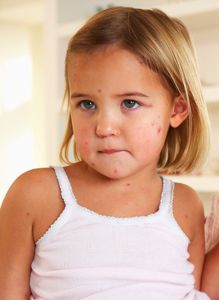 Chickenpox is a miserable condition that causes children and parents a great deal of distress. Itching makes it difficult to settle during the day or sleep at night, and continued scratching can lead to skin infection and scarring. Traditional treatments tend to dry out the skin and provide only temporary relief before itching comes back. Thankfully, modern gels and mousses are especially designed to reduce the risk of infection, are now available.
Chickenpox is a miserable condition that causes children and parents a great deal of distress. Itching makes it difficult to settle during the day or sleep at night, and continued scratching can lead to skin infection and scarring. Traditional treatments tend to dry out the skin and provide only temporary relief before itching comes back. Thankfully, modern gels and mousses are especially designed to reduce the risk of infection, are now available.
Let me dispel some of the myths surrounding chickenpox.
Myth: Once you’ve had chickenpox you are immune from it for life.
Fact:
When your child contracts chickenpox the body develops antibodies called immunoglobulin. It is these antibodies that fight off the chickenpox virus in later life. However not all those who contract the chickenpox virus will go on to produce protective levels of the vital antibodies and those that don’t may catch chickenpox again. A blood test can assess whether or not your child has immunity but this is not routinely offered in the NHS.
Myth: Scratching causes scarring.
Fact:
Usually only very persistent scratching causes scarring and most scars will fade after a few months. However, in around one in ten people some spots become infected with bacteria which, if left untreated with antibiotics can result in a scar. A topical product such as PoxClin Cool Mousse contains a natural bacterial blocker that helps prevent infection of the spots and therefore reduces the chances of scarring.
Myth: Chickenpox is a totally harmless childhood disease.
Fact:
Around one in 20 children will contract an ear infection as a result of chickenpox. Other rare complications include pneumonia and inflammation of the brain (encephalitis). Extremely rare complications include myocarditis (inflammation of the heart muscle), glomerulonephritis (kidney inflammation), appendicitis, hepatitis (inflammation of the liver), pancreatitis (inflammation of the pancreas), Henoch-Schönlein purpura (a condition that can affect the kidneys), orchitis (inflammation of the testes), arthritis and inflammation of parts of the eye.
Myth: If you have had chickenpox you will never get shingles.
Fact:
Shingles is caused by the same virus that causes chickenpox. As the virus does not completely clear from your body after you have chickenpox they may reactivate at some point in your life. Around one in five people who have had chickenpox will develop shingles at some point in their life.
Myth: Only adults or older people get shingles.
Fact:
Any person of any age who has had chickenpox can develop shingles. Children under 12 months old who have already had chickenpox are particularly susceptible. However, shingles most commonly occurs in people over the age of 50.
Myth: All children should be exposed to chickenpox as soon as possible.
Fact:
Chickenpox can be dangerous for any child with a low, or not fully developed immune system. This includes babies less than one month old, children with immune diseases such as leukaemia or HIV, and children who are on immuno-suppressant treatments such as chemotherapy or steroids. In addition, children under 12 months old who have had chickenpox are particularly susceptible to developing shingles.
Myth: There is no protection against chickenpox.
Fact:
There is a vaccine against the virus that causes chickenpox and this is part of the routine immunisation programme in the USA, Canada and Australia. In the UK the vaccine is only offered to groups such as healthcare workers and others with no previous history of chickenpox who are in close contact with people who have a weakened immune system.
Myth: There is no medical treatment for chickenpox.
Fact:
Chickenpox can be treated with an antiviral medicine such as aciclovir or immunoglobulin which can reduce the symptoms and likelihood of complications. Treatment is usually only needed for those with low immunity such as babies less than one month old, children who are taking medications such as chemotherapy, immune-suppressing drugs or steroids, those with immune diseases such as leukaemia or HIV, or with severe heart, lung or skin conditions. If your child has not already had chickenpox and is in one of these groups, contact your doctor urgently if they have contact with chickenpox or develops chickenpox symptoms.
Myth: The best way to reduce the fever caused by chickenpox is by cool sponging
Fact:
Cool sponging causes a constriction of the blood vessels just below the skin if the water is too cold. This traps heat deep in the body which can make the fever worse. Doctors now advise placing the child in a gentle flow of air at room temperature, such as near an open window. Paracetamol will bring down temperature. Do not give ibuprofen, aspirin or other non-steroidal anti-inflammatory drugs (NSAIDs) as these may increase the risk of developing serious complications.
Myth: The best treatment for itchy skin caused by chickenpox is calamine lotion.
Fact:
Calamine lotion is no longer recommended by many doctors because as soon as it dries on the skin it is no longer effective. Soothing cream, gel or mousse products such as PoxClin Cool Mousse have been clinically proven to reduce the effects of the itching. Other useful treatments include an age appropriate dose of anti-histamine which can reduce itching.
Myth: Certain foods such as shellfish or chicken increase skin irritation.
Fact:
There is no evidence to support this
PoxClin Cool Mousse is available from Boots, Sainsbury’s, Asda and independent pharmacists priced around £10.80 for 100 ml.